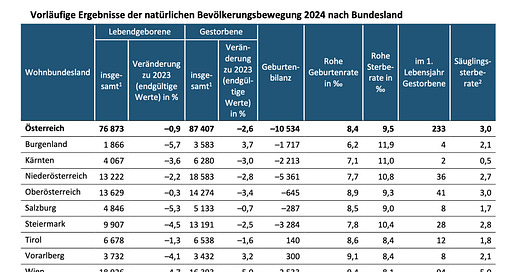Austria Reports Lowest No. of Births Ever
No discussion of the underlying causes is given: the C19 poison/death juices aren't mentioned, and neither are the origins of declining fertility: the socialist policies of the 1960s and 1970s
And now for something different: the consequences of what can only be described as Westerner’s unwillingness to continue the current system: declining birth rates.
Yes, I’ve written about birth rates many times, and most recently, ‘the science™’ mused about social media (which I think has a role to play):
I frankly believe birth rates to be a complex issue (meaning there’s many moving parts to this problem), yet I also find that the debate is lacking an open-minded approach as the Lord Voldemort—that one thing that must not be named—is omitted: the C19 poison/death juices, which we now ‘know™’ for a fact to adversely affect the unborn:
(I’ll just note, for the record, that this kind of phenomenon—‘shedding’—was however tacitly admitted as early as 2022: I’ve kept these receipts, too.)
Mankind is under a multi-pronged attack, with social media, environmental poisons (RoundUp, or glyphosate), and many other factors—ranging from mostly sedentary lifestyles to falling testosterone/rising levels of estrogen (think: hormonal birth control) to massive gaslighting of esp. the young adults to ‘get educated™’ and ‘have a career™’ before considering children.
And now—here’s an update from Statistik Austria, the official number-crunchers, and their considerations merit your attention (my translation, emphases, and [snark].
Average No. of Children per Woman At All-Time Low
Press release: 13 547-040/25 by Statistik Austria, 25 Feb. 2025 [source]
Fewer births and deaths in 2024, birth rate again negative: 76,873 children were born in Austria in 2024, 0.9% fewer than in 2023, according to preliminary results from Statistics Austria. In the same period, 87,407 people died, 2.6% fewer than in the previous year. The birth rate in 2024 was again negative at -10,534 (2023: -12,155). The average number of children per woman fell to a new all-time low of 1.31.
‘In 2024, Austria had a birth deficit for the fifth time in a row. There were 76,873 newborns compared to 87,407 deaths—in other words, 10,534 more people died than were born in 2024. The total fertility rate [hence TFR], i.e., the expected number of children per woman, fell to a new low of 1.31 in 2024’, explains Statistics Austria Director-General Tobias Thomas…
According to provisional data, births were down in eight federal states [there are nine such states] in 2024 compared to the final results for 2023. Burgenland (-5.7%) and Salzburg (-5.3%) saw the sharpest decline in births, followed by Styria (-4.5%) and Vorarlberg (-4.1%). The number of newborns fell least sharply in Upper Austria (-0.3%) and Tyrol (-1.3%). Vienna recorded an increase in births of +4.7% [guess where most migrants go to…]
According to preliminary figures, deaths in 2024 were lower than in the previous year in seven federal states. The decline was highest in Vienna (-5.0%) and lowest in Salzburg (-0.7%). In Burgenland (+3.7%) and Vorarlberg (+3.2%), more deaths were registered in 2024 than in the previous year.
The crude birth rate, i.e., the number of live births per 1,000 inhabitants, was 8.4‰ in Austria in 2024 in relation to the population figures. Vienna (9.4 ‰), Vorarlberg (9.1 ‰), Upper Austria (8.9 ‰), Tyrol (8.6 ‰) and Salzburg (8.5 ‰) recorded values above the national average. The crude death rate, i.e., the number of deaths per 1,000 inhabitants, was 9.5 ‰ for Austria and was above the Austrian average in Burgenland (11.9 ‰), Carinthia (11.0 ‰), Lower Austria (10.8 ‰) and Styria (10.4 ‰).
The birth balance, i.e., the balance of live births and deaths, was positive in three federal states in 2024, most markedly in Vienna (+2,533), followed by Vorarlberg (+300) and Tyrol (+140). In contrast, there were fewer newborns than deaths in six federal states in 2024, particularly in Lower Austria (-5,361), Styria (-3,284) and Carinthia (-2,213).
According to the preliminary results, the total fertility rate [TFR] in 2024 was 1.31 children per woman, slightly below the previous year’s figure of 1.32 and thus fell to a new all-time low.
Wohnbundesland = federal state; Lebendgeborene = live births vs. Gestorbene = deceased, both categories broken down in total numbers (insgesamt) and changes to 2023 (Veränderung zu 2023); Geburtenbilanz = births vs deaths; rohe Geburtenrate = raw birth rate; rohe Sterberate = raw death rate; im 1. Lebensjahr gestorben = infants who died before age 1; Säuglingssterberate = neonatal death rate
Further information may be found on the dedicated website.
Bottom Lines
This isn’t good news at-all: replace fertility rate is 2.11 children per woman, and as long as the age of mothers at first birth continues to climb, birth rates will go down.
Add to that the drastic problem of virtually unrestricted mass immigration, you can clearly see the writing on the wall (it says: ‘replacement migration’).
I wrote about this issue using Austrian data half a year ago—and I’m unhappy to report that, while birth and immigration rates are connected, that the number crunchers at Statistik Austria spilled the beans on these issues in no uncertain terms:
The only post-war cohort of women who gave birth to more than two children on average was the 1946/47 cohort with 2.05 births. Younger cohorts from the early 1970s, who have not yet completed their reproductive phase, are currently at around 1.65 children per woman...
Translation from the demographese: our entire ‘understanding™’ of recent history is bunk because ‘we’ have not exceeded replacement fertility rates since the Second World War. To raise the alarm over declining birth rates now is both warranted and undertaken mostly for the wrong reason (yes, mass immigration is a problem, but it is a symptom of an underlying societal problem):
The average fertility age (DFA) has risen steadily since the end of the 1970s and reached 30.0 years for the first time in Austria in 2011. Since then, it has increased nationwide by just over a year to 31.1 years by 2022. The regional range is currently 0.9 years, with a maximum in Vienna (31.7 years) and a minimum in Carinthia (30.7 years). In the second half of the 1970s, the average fertility age across Austria was 26.2 years, five years lower than at present...
So, age at first birth plays a huuuuuuuuge role in all of this, and if you look at that paragraph, you’ll immediately notice the proximate cause as having nothing to do with mass immigration since the late 1990s.
The proximal origins of the current predicament is—politics, specifically, the ‘progressive’-socialist domestic politics introduced in the 1970s: the expansion of public higher education, daytime care (what an Orwellian term, come to think of it), and, as a catch-all term, feminism: making women move into the labour market en masse is the issue here.
This is a simple fact that the demographers also noted (it’s actually hard to escape notice, come to think of it):
The current relatively low fertility level is closely linked to the increase in the fertility age [same as in, say, Norway, or elsewhere in the West]. Increased participation in education and higher employment among women, the associated career plans, but also the difficulties in reconciling work and family life are leading couples to postpone their desire to have children until a later age. As described above, this manifests itself in the long-term increase in the average fertility age. The forecast assumes that the DFA will rise to 33.5 years across Austria in the long term.
I’ve written this up in long-form in September 2024, if you’re interested:
It’s easy to blame mass migration, but that’s the symptom. Yes, I consider the UN’s hand in this nefarious, as is the collaboration by Western governments, academia, and legacy media.
Yet, the ‘debate™’ is so piss-poor that it’s hard to escape the conclusion it’s no wonder that we’re running around like a proverbial headless chicken.
Yes, an open, honest debate about birth rates, the relationship between men and women, and our society’s future would have to include mass migration, the nefarious role of NGOs, and supra-national organisations (such as the EU and the UN).
BUT.
These are all epiphenomena, meaning that their discussion and/or changes to any of the above is akin to tinkering around the edges.
The true origins of the decline of our societies is—the socialistic domestic policies; and, no, the US doesn’t get a pass, it’s L.B. Johnson’s ‘Great Society’ of the 1960s that turbo-charged this malaise in America, with left-wing revolutionaries like Willy Brandt (W Germany), Olof Palme (Sweden), and Bruno Kreisky (Austria) functioning as the prime culprits.
I understand that their policy proposals, while of course informed by their ideologies, were perhaps well-intentioned, and there’s a lot of good to be said about one or the other such policy.
Yet, half a century later, any clear-eyed observer cannot fail to note the corrosive, if not deadly, consequences of these left-wing policies.
As a consequence of these policies, both gov’t indebtedness and the number of public employees has shot up, as well as the age of mothers giving birth.
This is clearly a lot of things, but it ain’t sustainable, hence it won’t continue much longer.
Mass immigration was, in part, undertaken to address these demographic woes that came about as a result of disastrous policies. We also know that this is perhaps an even bigger blunder (time will tell), as innovation—the traditional Western way of addressing such predicaments—might save our societies, but if one also imports the Third World at the same time, it doesn’t take a genius to figure out what will follow: chaos.







We have so many anecdotes of people here who took the shots and then couldn’t conceive, had miscarriages, or disabled children. Literally I mean the majority of couples in our circle, not people we just heard about. Very sad. Here in many towns in Upper Austria most of us young and middle-aged folks who are independent thinkers avoided this stuff. My town had 62% take this first shot, 58% the second, and only about 40% a booster. But, even with 62%, anecdotally most young couples with children around here didn’t inject. We are the ones who will have multiple children and eventually lead Austria back, as much as Vienna is pulling in the opposite direction.
Solution? Vaccine mandates of course.
It always has to become worse and worst, before things change.
NO VIRUS!!! THERE IS NO F*KING VIRUS! So what are vaccines for? TO KILL and HARM and profit from it.